Leadership: Transformational Leadership & Organizational Innovation
VerifiedAdded on 2023/06/07
|7
|1522
|204
Essay
AI Summary
This essay examines the influence of transformational leadership on organizational performance, highlighting the roles of organizational learning and innovation. It emphasizes how transformational leaders foster emotional connections with followers, inspire higher values, and promote intellectual stimulation within an organization. The author favors transformational leadership for its visionary and creative approach to problem-solving and its ability to facilitate conversation among stakeholders. Key personal qualities of effective leaders include passion, vision, creativity, intellectual drive, and confidence. The essay also discusses the importance of qualities like humility, integrity, collaboration, courage, accountability, humanity, and judgment in a leader's professional development. It further applies transformational leadership principles to address challenges in Aboriginal health, suggesting innovative models and organizational changes to improve the quality of life for Aboriginal people. Desklib provides access to similar solved assignments and resources.
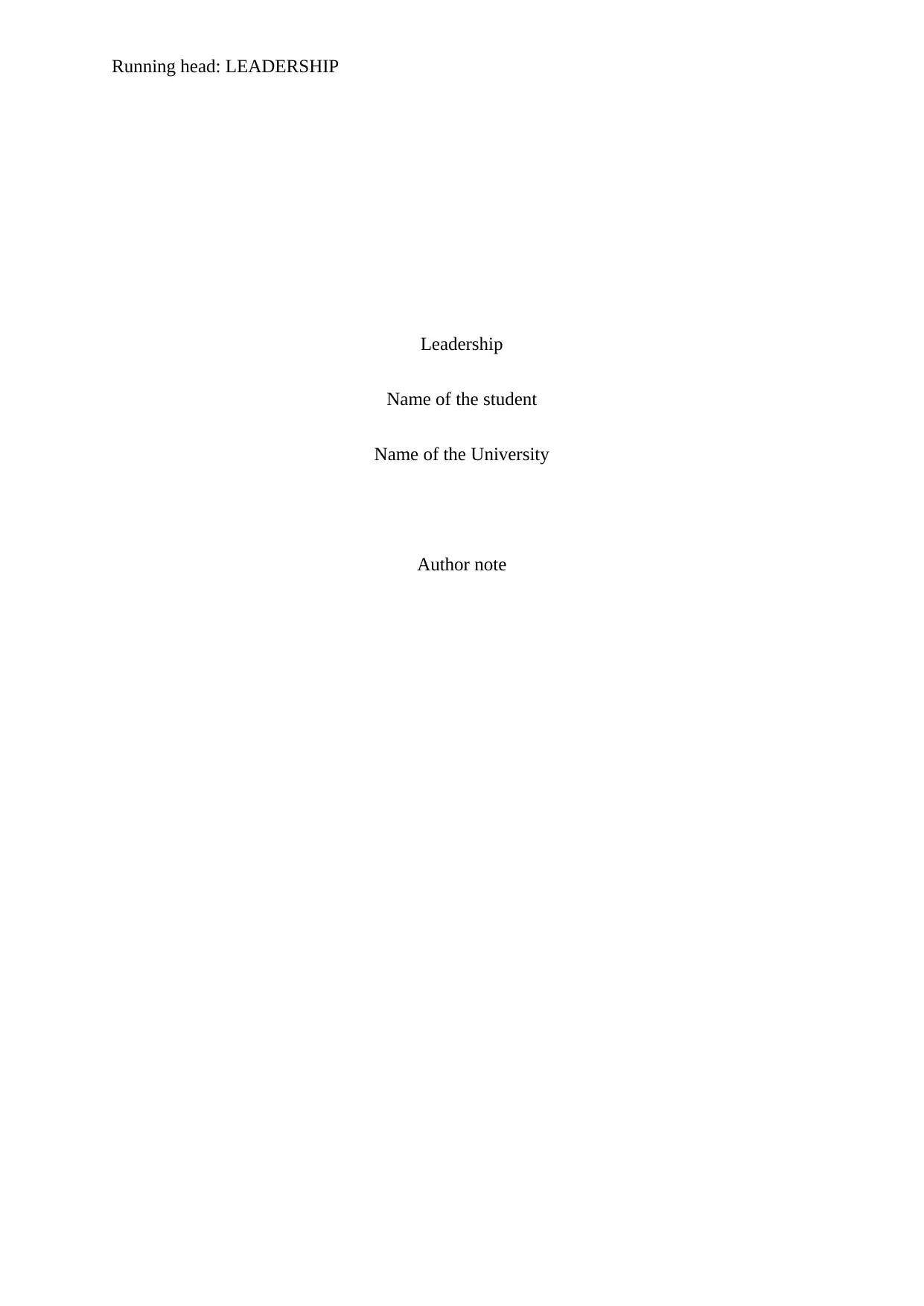
Running head: LEADERSHIP
Leadership
Name of the student
Name of the University
Author note
Leadership
Name of the student
Name of the University
Author note
Paraphrase This Document
Need a fresh take? Get an instant paraphrase of this document with our AI Paraphraser
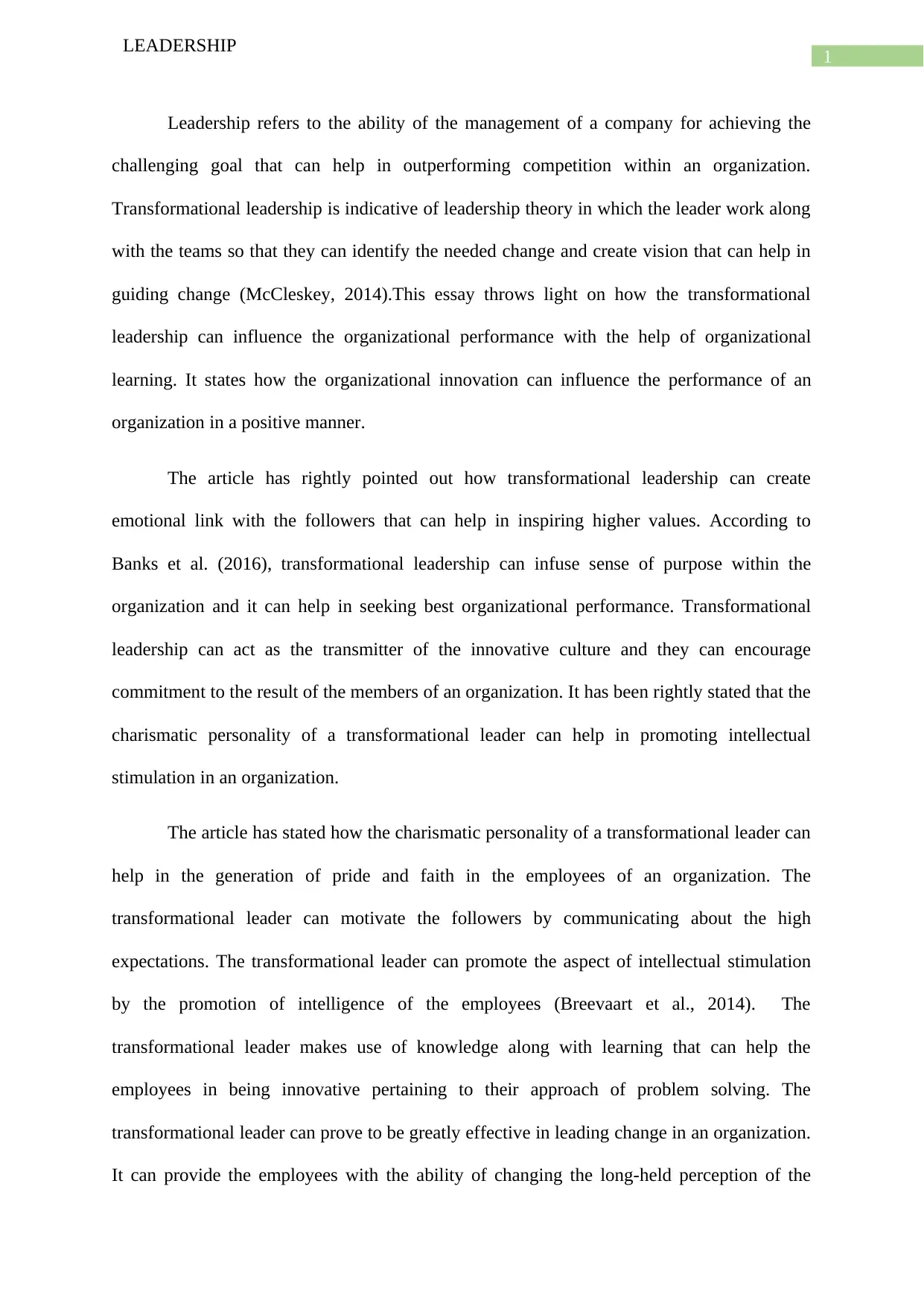
1
LEADERSHIP
Leadership refers to the ability of the management of a company for achieving the
challenging goal that can help in outperforming competition within an organization.
Transformational leadership is indicative of leadership theory in which the leader work along
with the teams so that they can identify the needed change and create vision that can help in
guiding change (McCleskey, 2014).This essay throws light on how the transformational
leadership can influence the organizational performance with the help of organizational
learning. It states how the organizational innovation can influence the performance of an
organization in a positive manner.
The article has rightly pointed out how transformational leadership can create
emotional link with the followers that can help in inspiring higher values. According to
Banks et al. (2016), transformational leadership can infuse sense of purpose within the
organization and it can help in seeking best organizational performance. Transformational
leadership can act as the transmitter of the innovative culture and they can encourage
commitment to the result of the members of an organization. It has been rightly stated that the
charismatic personality of a transformational leader can help in promoting intellectual
stimulation in an organization.
The article has stated how the charismatic personality of a transformational leader can
help in the generation of pride and faith in the employees of an organization. The
transformational leader can motivate the followers by communicating about the high
expectations. The transformational leader can promote the aspect of intellectual stimulation
by the promotion of intelligence of the employees (Breevaart et al., 2014). The
transformational leader makes use of knowledge along with learning that can help the
employees in being innovative pertaining to their approach of problem solving. The
transformational leader can prove to be greatly effective in leading change in an organization.
It can provide the employees with the ability of changing the long-held perception of the
LEADERSHIP
Leadership refers to the ability of the management of a company for achieving the
challenging goal that can help in outperforming competition within an organization.
Transformational leadership is indicative of leadership theory in which the leader work along
with the teams so that they can identify the needed change and create vision that can help in
guiding change (McCleskey, 2014).This essay throws light on how the transformational
leadership can influence the organizational performance with the help of organizational
learning. It states how the organizational innovation can influence the performance of an
organization in a positive manner.
The article has rightly pointed out how transformational leadership can create
emotional link with the followers that can help in inspiring higher values. According to
Banks et al. (2016), transformational leadership can infuse sense of purpose within the
organization and it can help in seeking best organizational performance. Transformational
leadership can act as the transmitter of the innovative culture and they can encourage
commitment to the result of the members of an organization. It has been rightly stated that the
charismatic personality of a transformational leader can help in promoting intellectual
stimulation in an organization.
The article has stated how the charismatic personality of a transformational leader can
help in the generation of pride and faith in the employees of an organization. The
transformational leader can motivate the followers by communicating about the high
expectations. The transformational leader can promote the aspect of intellectual stimulation
by the promotion of intelligence of the employees (Breevaart et al., 2014). The
transformational leader makes use of knowledge along with learning that can help the
employees in being innovative pertaining to their approach of problem solving. The
transformational leader can prove to be greatly effective in leading change in an organization.
It can provide the employees with the ability of changing the long-held perception of the
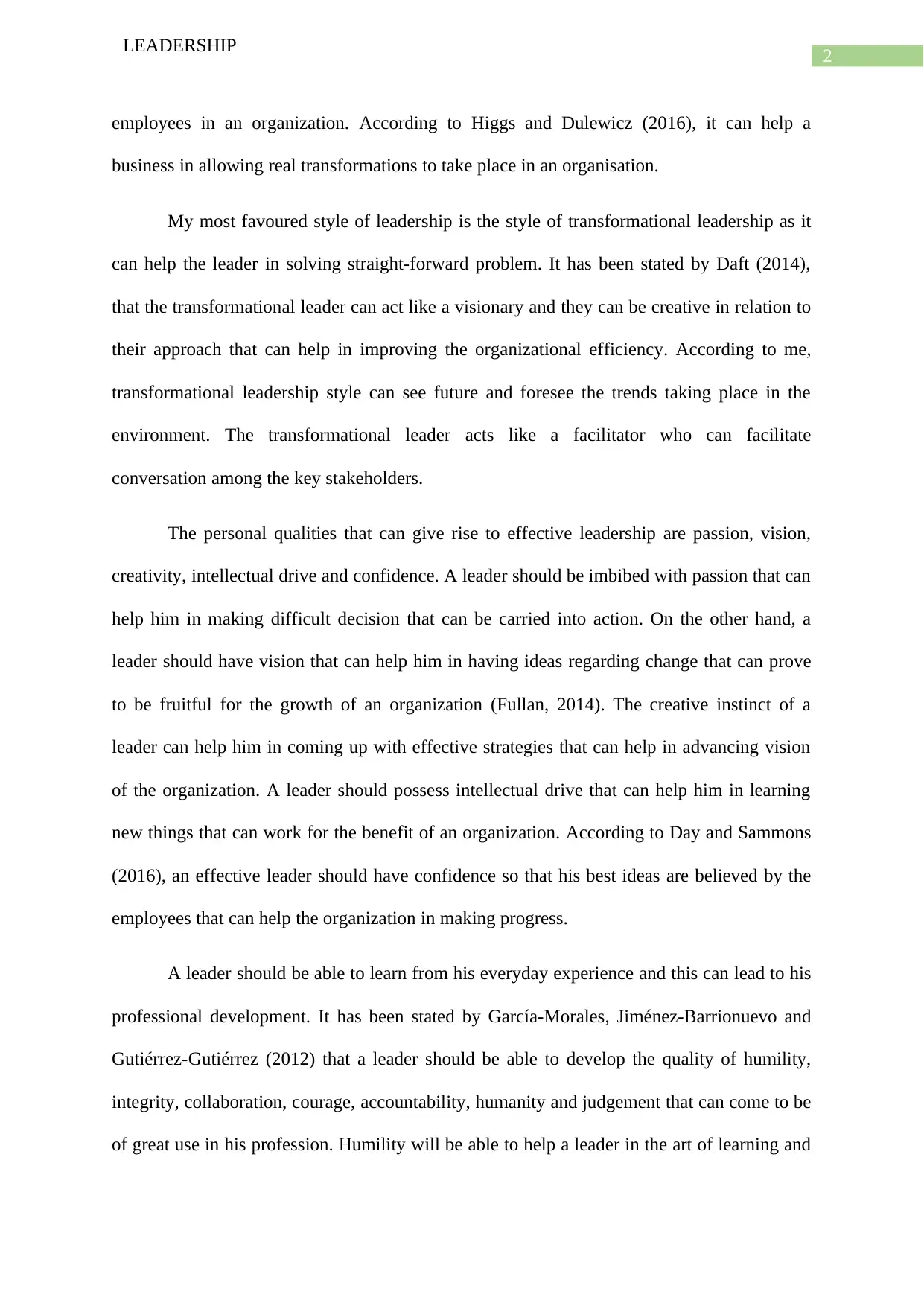
2
LEADERSHIP
employees in an organization. According to Higgs and Dulewicz (2016), it can help a
business in allowing real transformations to take place in an organisation.
My most favoured style of leadership is the style of transformational leadership as it
can help the leader in solving straight-forward problem. It has been stated by Daft (2014),
that the transformational leader can act like a visionary and they can be creative in relation to
their approach that can help in improving the organizational efficiency. According to me,
transformational leadership style can see future and foresee the trends taking place in the
environment. The transformational leader acts like a facilitator who can facilitate
conversation among the key stakeholders.
The personal qualities that can give rise to effective leadership are passion, vision,
creativity, intellectual drive and confidence. A leader should be imbibed with passion that can
help him in making difficult decision that can be carried into action. On the other hand, a
leader should have vision that can help him in having ideas regarding change that can prove
to be fruitful for the growth of an organization (Fullan, 2014). The creative instinct of a
leader can help him in coming up with effective strategies that can help in advancing vision
of the organization. A leader should possess intellectual drive that can help him in learning
new things that can work for the benefit of an organization. According to Day and Sammons
(2016), an effective leader should have confidence so that his best ideas are believed by the
employees that can help the organization in making progress.
A leader should be able to learn from his everyday experience and this can lead to his
professional development. It has been stated by García-Morales, Jiménez-Barrionuevo and
Gutiérrez-Gutiérrez (2012) that a leader should be able to develop the quality of humility,
integrity, collaboration, courage, accountability, humanity and judgement that can come to be
of great use in his profession. Humility will be able to help a leader in the art of learning and
LEADERSHIP
employees in an organization. According to Higgs and Dulewicz (2016), it can help a
business in allowing real transformations to take place in an organisation.
My most favoured style of leadership is the style of transformational leadership as it
can help the leader in solving straight-forward problem. It has been stated by Daft (2014),
that the transformational leader can act like a visionary and they can be creative in relation to
their approach that can help in improving the organizational efficiency. According to me,
transformational leadership style can see future and foresee the trends taking place in the
environment. The transformational leader acts like a facilitator who can facilitate
conversation among the key stakeholders.
The personal qualities that can give rise to effective leadership are passion, vision,
creativity, intellectual drive and confidence. A leader should be imbibed with passion that can
help him in making difficult decision that can be carried into action. On the other hand, a
leader should have vision that can help him in having ideas regarding change that can prove
to be fruitful for the growth of an organization (Fullan, 2014). The creative instinct of a
leader can help him in coming up with effective strategies that can help in advancing vision
of the organization. A leader should possess intellectual drive that can help him in learning
new things that can work for the benefit of an organization. According to Day and Sammons
(2016), an effective leader should have confidence so that his best ideas are believed by the
employees that can help the organization in making progress.
A leader should be able to learn from his everyday experience and this can lead to his
professional development. It has been stated by García-Morales, Jiménez-Barrionuevo and
Gutiérrez-Gutiérrez (2012) that a leader should be able to develop the quality of humility,
integrity, collaboration, courage, accountability, humanity and judgement that can come to be
of great use in his profession. Humility will be able to help a leader in the art of learning and
⊘ This is a preview!⊘
Do you want full access?
Subscribe today to unlock all pages.

Trusted by 1+ million students worldwide
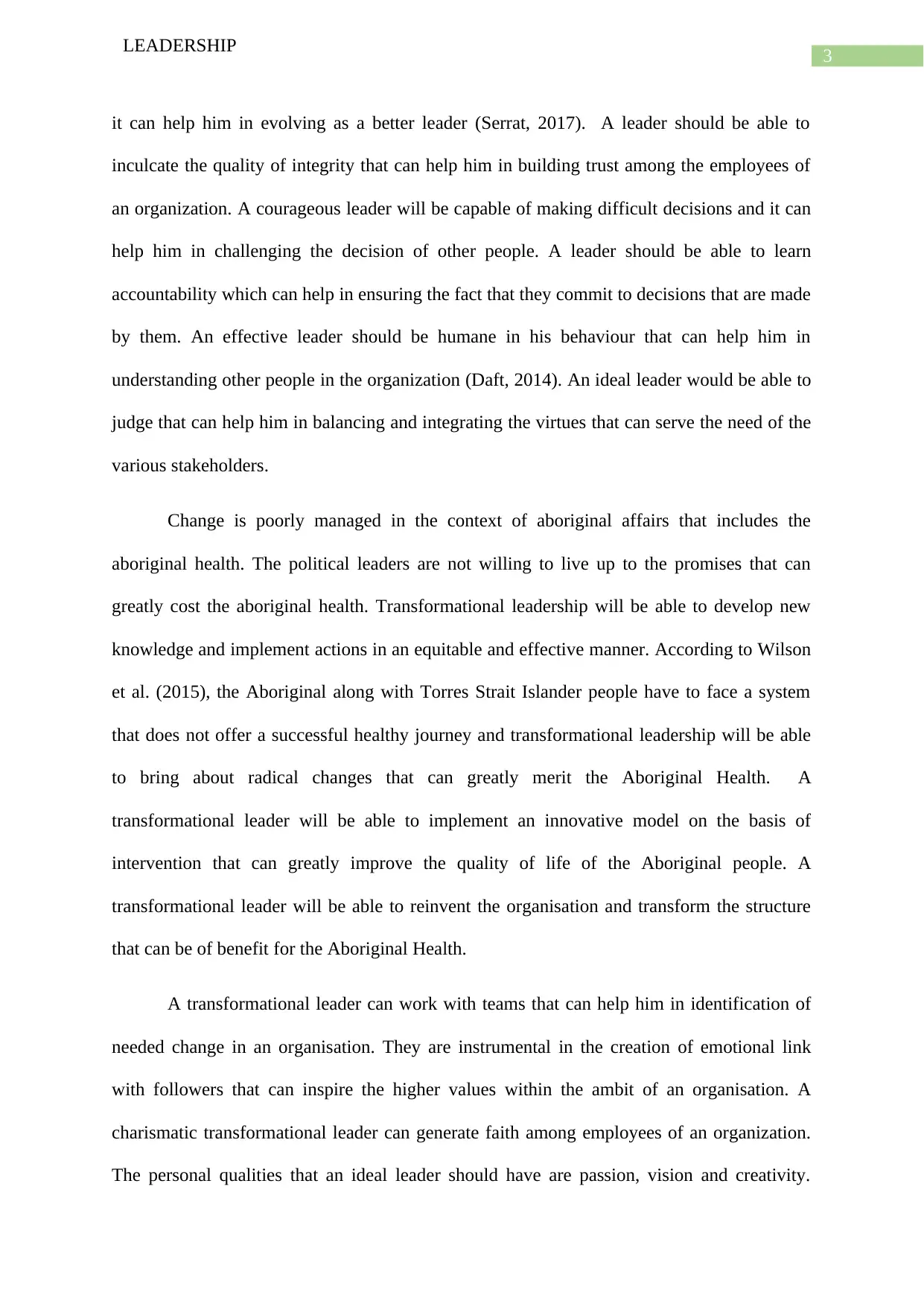
3
LEADERSHIP
it can help him in evolving as a better leader (Serrat, 2017). A leader should be able to
inculcate the quality of integrity that can help him in building trust among the employees of
an organization. A courageous leader will be capable of making difficult decisions and it can
help him in challenging the decision of other people. A leader should be able to learn
accountability which can help in ensuring the fact that they commit to decisions that are made
by them. An effective leader should be humane in his behaviour that can help him in
understanding other people in the organization (Daft, 2014). An ideal leader would be able to
judge that can help him in balancing and integrating the virtues that can serve the need of the
various stakeholders.
Change is poorly managed in the context of aboriginal affairs that includes the
aboriginal health. The political leaders are not willing to live up to the promises that can
greatly cost the aboriginal health. Transformational leadership will be able to develop new
knowledge and implement actions in an equitable and effective manner. According to Wilson
et al. (2015), the Aboriginal along with Torres Strait Islander people have to face a system
that does not offer a successful healthy journey and transformational leadership will be able
to bring about radical changes that can greatly merit the Aboriginal Health. A
transformational leader will be able to implement an innovative model on the basis of
intervention that can greatly improve the quality of life of the Aboriginal people. A
transformational leader will be able to reinvent the organisation and transform the structure
that can be of benefit for the Aboriginal Health.
A transformational leader can work with teams that can help him in identification of
needed change in an organisation. They are instrumental in the creation of emotional link
with followers that can inspire the higher values within the ambit of an organisation. A
charismatic transformational leader can generate faith among employees of an organization.
The personal qualities that an ideal leader should have are passion, vision and creativity.
LEADERSHIP
it can help him in evolving as a better leader (Serrat, 2017). A leader should be able to
inculcate the quality of integrity that can help him in building trust among the employees of
an organization. A courageous leader will be capable of making difficult decisions and it can
help him in challenging the decision of other people. A leader should be able to learn
accountability which can help in ensuring the fact that they commit to decisions that are made
by them. An effective leader should be humane in his behaviour that can help him in
understanding other people in the organization (Daft, 2014). An ideal leader would be able to
judge that can help him in balancing and integrating the virtues that can serve the need of the
various stakeholders.
Change is poorly managed in the context of aboriginal affairs that includes the
aboriginal health. The political leaders are not willing to live up to the promises that can
greatly cost the aboriginal health. Transformational leadership will be able to develop new
knowledge and implement actions in an equitable and effective manner. According to Wilson
et al. (2015), the Aboriginal along with Torres Strait Islander people have to face a system
that does not offer a successful healthy journey and transformational leadership will be able
to bring about radical changes that can greatly merit the Aboriginal Health. A
transformational leader will be able to implement an innovative model on the basis of
intervention that can greatly improve the quality of life of the Aboriginal people. A
transformational leader will be able to reinvent the organisation and transform the structure
that can be of benefit for the Aboriginal Health.
A transformational leader can work with teams that can help him in identification of
needed change in an organisation. They are instrumental in the creation of emotional link
with followers that can inspire the higher values within the ambit of an organisation. A
charismatic transformational leader can generate faith among employees of an organization.
The personal qualities that an ideal leader should have are passion, vision and creativity.
Paraphrase This Document
Need a fresh take? Get an instant paraphrase of this document with our AI Paraphraser

4
LEADERSHIP
Developing the quality of humility, integrity, accountability and judgement can help a leader
in his professional domain. Transformational leader can make use of an innovative model that
can improve the health of the Aboriginal people.
LEADERSHIP
Developing the quality of humility, integrity, accountability and judgement can help a leader
in his professional domain. Transformational leader can make use of an innovative model that
can improve the health of the Aboriginal people.
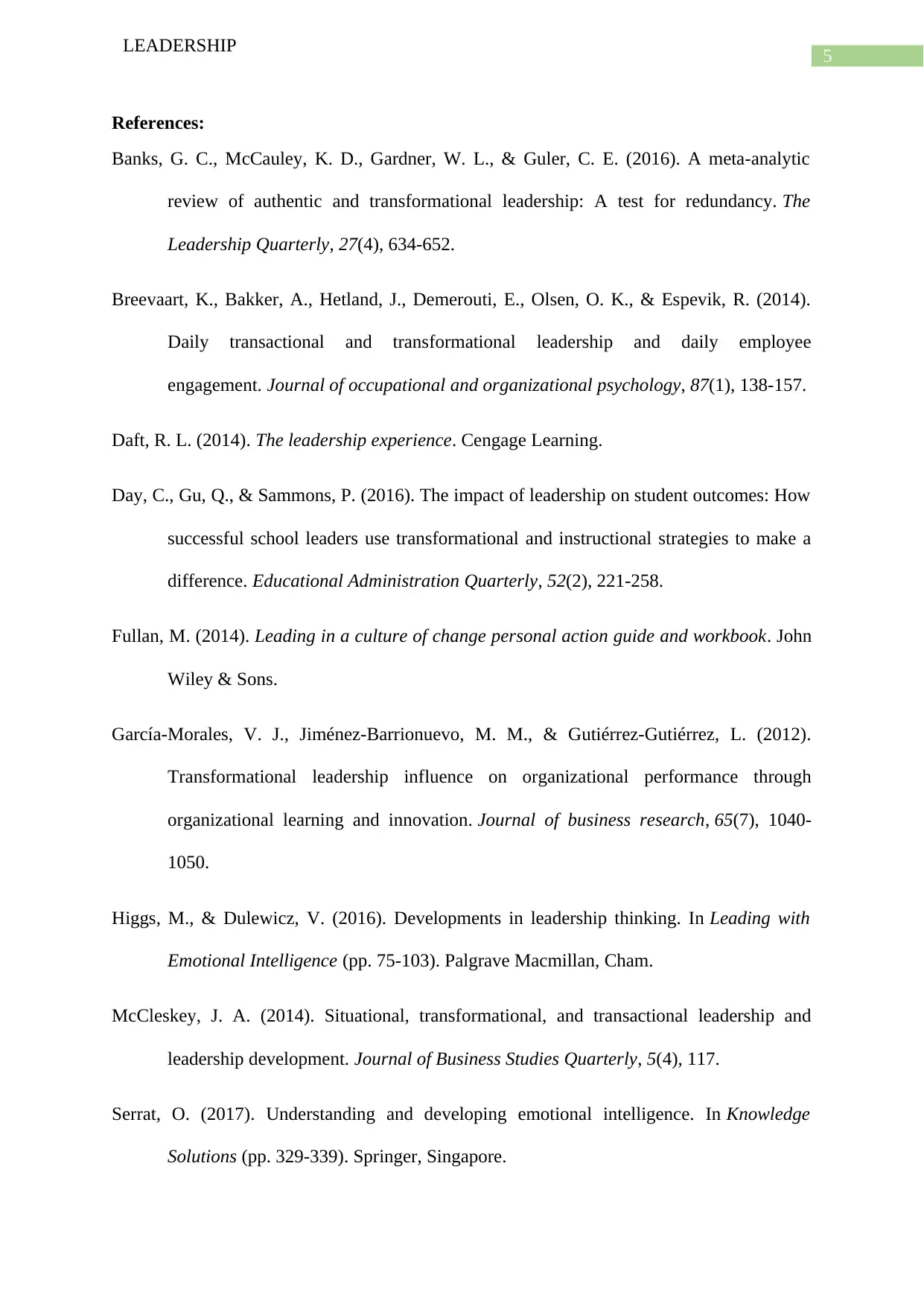
5
LEADERSHIP
References:
Banks, G. C., McCauley, K. D., Gardner, W. L., & Guler, C. E. (2016). A meta-analytic
review of authentic and transformational leadership: A test for redundancy. The
Leadership Quarterly, 27(4), 634-652.
Breevaart, K., Bakker, A., Hetland, J., Demerouti, E., Olsen, O. K., & Espevik, R. (2014).
Daily transactional and transformational leadership and daily employee
engagement. Journal of occupational and organizational psychology, 87(1), 138-157.
Daft, R. L. (2014). The leadership experience. Cengage Learning.
Day, C., Gu, Q., & Sammons, P. (2016). The impact of leadership on student outcomes: How
successful school leaders use transformational and instructional strategies to make a
difference. Educational Administration Quarterly, 52(2), 221-258.
Fullan, M. (2014). Leading in a culture of change personal action guide and workbook. John
Wiley & Sons.
García-Morales, V. J., Jiménez-Barrionuevo, M. M., & Gutiérrez-Gutiérrez, L. (2012).
Transformational leadership influence on organizational performance through
organizational learning and innovation. Journal of business research, 65(7), 1040-
1050.
Higgs, M., & Dulewicz, V. (2016). Developments in leadership thinking. In Leading with
Emotional Intelligence (pp. 75-103). Palgrave Macmillan, Cham.
McCleskey, J. A. (2014). Situational, transformational, and transactional leadership and
leadership development. Journal of Business Studies Quarterly, 5(4), 117.
Serrat, O. (2017). Understanding and developing emotional intelligence. In Knowledge
Solutions (pp. 329-339). Springer, Singapore.
LEADERSHIP
References:
Banks, G. C., McCauley, K. D., Gardner, W. L., & Guler, C. E. (2016). A meta-analytic
review of authentic and transformational leadership: A test for redundancy. The
Leadership Quarterly, 27(4), 634-652.
Breevaart, K., Bakker, A., Hetland, J., Demerouti, E., Olsen, O. K., & Espevik, R. (2014).
Daily transactional and transformational leadership and daily employee
engagement. Journal of occupational and organizational psychology, 87(1), 138-157.
Daft, R. L. (2014). The leadership experience. Cengage Learning.
Day, C., Gu, Q., & Sammons, P. (2016). The impact of leadership on student outcomes: How
successful school leaders use transformational and instructional strategies to make a
difference. Educational Administration Quarterly, 52(2), 221-258.
Fullan, M. (2014). Leading in a culture of change personal action guide and workbook. John
Wiley & Sons.
García-Morales, V. J., Jiménez-Barrionuevo, M. M., & Gutiérrez-Gutiérrez, L. (2012).
Transformational leadership influence on organizational performance through
organizational learning and innovation. Journal of business research, 65(7), 1040-
1050.
Higgs, M., & Dulewicz, V. (2016). Developments in leadership thinking. In Leading with
Emotional Intelligence (pp. 75-103). Palgrave Macmillan, Cham.
McCleskey, J. A. (2014). Situational, transformational, and transactional leadership and
leadership development. Journal of Business Studies Quarterly, 5(4), 117.
Serrat, O. (2017). Understanding and developing emotional intelligence. In Knowledge
Solutions (pp. 329-339). Springer, Singapore.
⊘ This is a preview!⊘
Do you want full access?
Subscribe today to unlock all pages.

Trusted by 1+ million students worldwide

6
LEADERSHIP
Wilson, A. M., Magarey, A. M., Jones, M., O'Donnell, K., & Kelly, J. (2015). Attitudes and
characteristics of health professionals working in Aboriginal health. Rural & Remote
Health, 15(1).
LEADERSHIP
Wilson, A. M., Magarey, A. M., Jones, M., O'Donnell, K., & Kelly, J. (2015). Attitudes and
characteristics of health professionals working in Aboriginal health. Rural & Remote
Health, 15(1).
1 out of 7
Related Documents
Your All-in-One AI-Powered Toolkit for Academic Success.
+13062052269
info@desklib.com
Available 24*7 on WhatsApp / Email
![[object Object]](/_next/static/media/star-bottom.7253800d.svg)
Unlock your academic potential
Copyright © 2020–2025 A2Z Services. All Rights Reserved. Developed and managed by ZUCOL.





